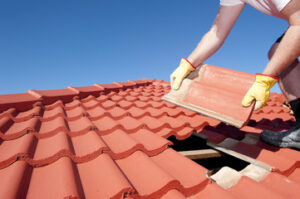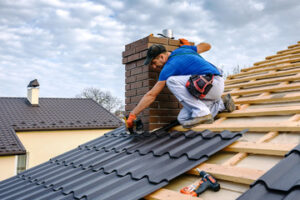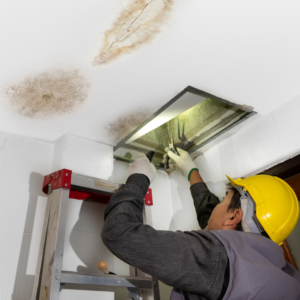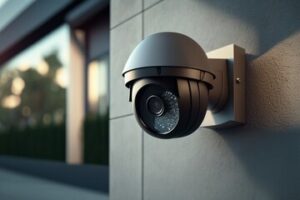A roof is an important component of any home and serves a vital role in protecting the building from harsh weather conditions. Getting it installed properly is crucial.

The roofing process involves a few key steps. Before starting, it’s a good idea to prepare the work site by pruning back nearby tree branches and moving outdoor furniture, ceramic landscaping elements and other items that could be damaged during the installation.
Before choosing a roofer, it’s important to take the time to research potential contractors. Ask friends and neighbors for recommendations and scour the internet for reviews. Once you’ve narrowed your options, schedule an appointment to meet with the contractor at your home. During this meeting, you should ask each contractor for references and examples of their work. Look for a professional who is enthusiastic, knowledgeable and attentive to your questions and concerns.
You should also find out how long the company has been in business. Experience plays a big role in the quality of roofing work, as seasoned roofers will have more knowledge about proper installation techniques and what materials are best suited for your area. Additionally, a reputable roofer will have an established business and will be able to honor any warranties or guarantees should something go wrong with your new roof.
Once you’ve chosen a roofer, prepare your house and property for the work to begin. Move any outdoor furniture, grills, potted plants and lawn ornaments away from the work area. You should also park your car across the street or in front of a neighbor to give the roofers easy access to your driveway for dumpsters and vehicles.
Inside your home, removing wall hangings and other decorations is a good idea. The vibrations from the machinery used to replace your roof can shake things on your walls, potentially causing them to fall and become damaged. In addition, dust and debris can easily settle in areas where these items are stored.
You should also make arrangements for children and pets while the work is being done. Putting in a new roof can be noisy and stressful, especially for young children who may not understand why they aren’t allowed to play outside or sleep in their own rooms. If possible, enlist the help of family and friends to watch and care for children and pets while the work is being completed. If this isn’t an option, consider having the children stay at Grandma’s or with other family members during the duration of the project.
Preparing for the Work
Whether you are replacing an existing roof or starting from scratch, your roofing professional will begin with a thorough inspection. This is to ensure that the sheathing and roof deck are in good condition and can support the weight of the new roofing materials. The inspection may also reveal repairs that are necessary to prevent future water intrusion or other problems.
Next, the roofer will select and order your roofing materials. This is a critical step, as there are a wide range of styles and materials to choose from. The best roofers will guide you through your options and help you select a material that fits with your goals, architecture and budget.
Once the roofers have the materials, they will set to work. They will start with the elements that are hidden from view, such as the flashing and drip edge. These components will be installed to protect the underlying layers of the roof and ensure that your home is well-ventilated and waterproof.
The flashing is a metal material that will be installed around chimneys, joints and other spots that are prone to leaks. It will direct water away from these areas and prevent seepage. The drip edge is a strip of weatherproof material that will be installed along the edge of the roof. This will help to protect the soffit and fascia from moisture, and will also ensure that the shingles do not come loose.
After the flashing and drip edge are in place, the roofers will begin to lay the underlayment. This is a layer of self-sticking material that will be attached to the roof sheathing, with tar paper or felt on top for additional protection. The roofers will overlap the first row of underlayment by six inches and nail it down with cap nails that are close to the edge and then spread out more towards the middle.
Once the underlayment is in place, the roofers will install a ridge cap. This is the final piece of the puzzle that will protect the underlying roof from water and snow, and will also prevent the shingles from blowing off in high winds. The roofers will then move on to the shingle installation. They will stagger the rows and apply the shingles in a careful manner to ensure that they are secured. They will then apply caulking to the raw edges of the shingles and trim any excess materials from the roof.
Obtaining Permits
Many homeowners consider permits to be a mere formality, but they are a crucial part of ensuring that your roofing project adheres to local building codes and safety standards. In addition, the work of a roofer with a permit will likely be more carefully monitored than that of a roofer without one, which can help to prevent problems like water damage or structural failure down the line.
Permit requirements vary by state, so it’s important to contact your city or town before beginning any work on your roof. Typically, you will need to submit a detailed application along with a fee payment. Once your application has been approved, you will be notified and can begin the work.
Having the proper permits in place is essential because it ensures that the work on your roof is carried out by certified professionals who are qualified and experienced. It also allows you to verify that the individuals working on your roof meet certain minimum insurance requirements, including liability coverage.
Aside from the legal repercussions of undertaking roofing work without a permit, it’s also important to keep in mind that having unpermitted work completed on your home can make it difficult or even impossible to sell it later on. Furthermore, it may make it difficult to obtain homeowner’s or other types of insurance.
As the envelope that protects your home from the elements, your roof is vital to its integrity and comfort. Aside from keeping you warm and dry, your roof keeps intruders out and the elements out of your living space. So it goes without saying that you want to make sure any work done on it is up to your community’s standards.
The exact definition of “structural work” can vary a little bit by municipality, but it usually refers to anything that affects the actual bones of your house, such as replacing joists or building a new deck. Replacing a few shingles and other minor repairs are unlikely to require a permit, but major replacements or additions would definitely fall into this category. Regardless of whether or not you need a permit, your roofing contractor will have to file for a counter plan check and pass any inspections that are required.
Getting Started
The roof is an essential part of any building or home. It protects the interior of your structure, safeguards occupants and possessions, and contributes to its aesthetic value. It is vitally important to ensure that your roofing system is installed correctly, and doing so requires a lot of work and planning. It’s not something you should try to take on yourself, as doing so may result in a host of problems like roof leaks, property damage, mold and pest infestations, and even structural instability.
Choosing a roofing material is an important decision, and one that should be made carefully. There are many different types of roofing materials, each with its own advantages and disadvantages. You should consider the materials in relation to your home’s architectural style, local weather conditions, and your personal preferences. Popular choices include asphalt shingles, which are cost-effective and offer good weather resistance. Metal roofs, on the other hand, are known for their longevity and durability.
Before any roof installation begins, it’s critical that the roof is inspected thoroughly. The professionals you hire should perform a thorough inspection of the existing roof and check for any signs of water damage or rot. They will also measure the square footage of your roof to determine how much material is needed for the project. They will also inspect and repair any damaged flashing or vents, and they will cover any landscaping plants to keep them from getting wet.
Once the site is prepared, the professional roofers will begin their work. They will lay out the tools and materials that are needed, and they will create a detailed plan for the project. They will also take precise measurements to calculate the amount of materials that are needed, ensuring that they have everything in place for a smooth installation process.
They will also begin to install the shingles. This is a meticulous process that requires a great deal of attention to detail. The shingles will be fastened with the proper nails and flashing, and they will be overlapped so that no area of the roof is exposed. They will also be cut if necessary for them to fit. Once the shingles are installed, they will be topped with a ridge cap, which is made of shingles that are flipped upside down and are fastened to the shingle row above it.








